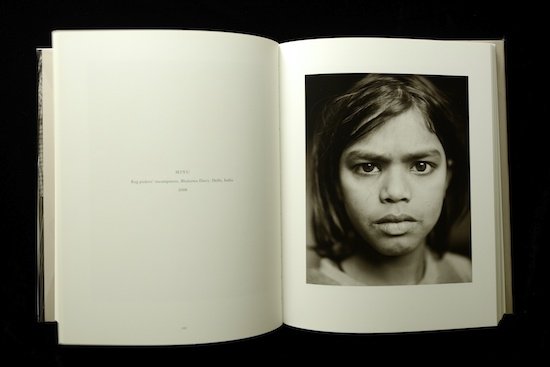Portraits
Fazal Sheikh
6.75 x 8.25, 304 pages, hardcover
Steidl, 2011
$65.00
Reviewed by Tim McLaughlin
A portrait almost always carries the weight of a story behind it. That is, I think, what separates the successful portrait from a failure. It might even be what separates a portrait from a mere image (if we are talking about photography) or a portrait from a mere likeness (if we are speaking about painting or illustration). A successful portrait has a story and a voice that speaks through the image, wanting to tell it.
The story behind the portraits of Fazal Sheikh is one of displacement and dispossession. It is not a pleasant story, for human nature is often unrelenting in its violence. Conflict can destroy the very landscape, and where there is no habitation the local population will become refugees. Once driven from their homeland the migrants will loose what little entitlement they may have had.
But this is not really the story behind the portraits, rather it is the circumstance under which the portraits have been made. The story, that weight of narrative that rests behind the image, is much more personal. It is, we suspect, much more profound, terrifying, and tragic than could be expressed in words. Yet despite the circumstance of the portraits and the stories behind them, these are humane pictures. There is a kindness in them, almost a tenderness, and a sense that even in the face of hopelessness there is a fundamental human dignity. There is respect and, evidently, a collaboration between the subject and photographer to tell a story. Some of the photographs are quite beautiful. Many convey a disconcerting intimacy.
Each of the portraits is accompanied by a short text. Sometimes it is just a name and location and sometimes it is a more complete story— the result of interviews conducted by Sheikh.
The book follows Sheikhs work over almost twenty years. He first visited a series of Kenyan refugee camps in 1992. The camps were set up to accommodate those fleeing wars in Ethiopia, Sudan and Somalia. There were additional camps in Malawi due to the war in Mozambique and after the genocide in Rwanda large refugee camps were set up in Tanzania. The text in Sheikh's early book A Sense of Common Ground (Scalo 1996) explains the origins of his method of working:
Fazal Sheikh worked among these refugee communities and began to learn about their experiences. It was here that he first witnessed the lightning visits of international photojournalists, who grabbed their stories and left in less than 24 hours. ‘I remembered watching them working and feeling a sense of unease, an inability to follow along and make the expected photographs,’ he said later. He decided to remain in the camps for extended periods, asking the elders for permission to invite their people to sit for a portrait. The portraits he made in those first months in Kenya established a way of working that has remained fundamentally the same ever since: a simple, direct, respectful rendering of one person, or a group, in front of the camera.
In addition to Sheikh’s photographs, Portraits also contains the essay "Trees, Hands, Stars, and Veils: The Portrait in Ruins" by the eminent Princeton scholar Eduardo Cadava. An Associate Member of the Department of Comparative Literature and a teacher in Princeton’s English Department, Cadava is also the author of Words of Light: Theses on the Photography of History and the editor of Cities Without Citizens. He is on familiar territory with Sheikh’s photographs and at the outset he sets up the fundamental crisis in human rights that underpins the book:
The crisis within human rights arises from the fact that, with the appearance of the refugee, the presumably sacred and inalienable rights of man are shown to be entirely alienable, to lack any protection or reality at the very moment in which they can no longer be understood as rights belonging to citizens of a state, or to members of a particular political community. In other words, it is precisely when the non-citizen appears, when the human is divorced from citizenship (even if it citizenship itself that often defines the human) or forced to move from the place that grants him or her citizenship, that rights are lost.
Cadava also provides an introduction to Sheikhs work, giving the scope and location of his various projects over time. Yet the rest of Cadava’s essay seems uneven. His contemplation and reading of the photographs, presented in the style of an academic essay, is at odds with the direct simplicity of the photos themselves. I welcome the political and historic context, but I cannot help but imagine that the subjects would have little use for such erudite prose with its emphasis on (for example) the postmodern tussle between “the multiplication and proliferation of the archival traces which simultaneously constitute and deconstitute her face ...”
One passage in particular troubled me, even after repeated readings:
What is at stake in the encounter with Sheikh’s photographs is not simply the possibility of seeing and understanding what cannot be seen directly within them but also the necessity of bearing witness to what history has silenced or sought to conceal (which nevertheless has left its traces on their surfaces), to what, arising from the days and nights of memory that are inscribed within them, haunts us, and encourages us to think about the loss and dispossession for which we remain, still today, responsible.
It seems to me that what is at stake with Sheikh’s photographs is not the amorphous agency of history, nor a tenuous culpability that can be attributed to the reader, but rather a notion of dignity and perseverance. What is at stake is this: in spite of the inventiveness of human cruelty and the caprice of fate, the dispossessed do have an identity. They have a name, and a face, and through these portraits they have a story.









